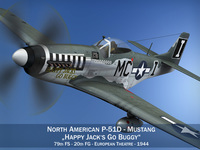Features:
- Inside scene: - model - 21 textures, 2 materials, 1 alphamap
- No cleaning up necessary, just drop your models into the scene and start rendering.
- No special plugin needed to open scene.
- Phong shading interpolation / Smoothing - 35°
-The files contains seperate parts for a Flying and a Standing-Version
- NOTE - In obj, lwo and fbx the Alphamap for the propellor (Run_Alpha) in the fly-version must manually load in the Materialcanal / Opacitycanal.
- c4d - Polygones - 137505 Vertices - 109142 - 32 Objects - 25 textures - 1 materials - 1 alpha-map
- obj File - lwo file - fbx - File Version 2010
The first major production version was the P-38E, which had a 20mm cannon rather than the earlier 37mm cannon. Production of the E began in September 1941 and 210 were built. The next version, the P-38F, introduced pylon racks that could carry either bombs or droppable fuel tanks, greatly extending its range. Production of the G began in August 1942, followed by the P-38H in May 1943, which had a more powerful version of the Allison V-1710 engine.The P-38J, introduced in August 1943, was considerably improved over earlier models. It had better cockpit heating (a notable problem on earlier models), more efficient cooling for its engines, a flat bulletproof windscreen, additional fuel in the wings, and increased maneuverability.
When the Lightning began combat operations from England in September 1943, it was the only fighter with the range to escort bombers into Germany.
The Lightning truly shined in the Pacific theater; seven of the top eight scoring USAAF aces in the Pacific flew the P-38. On April 18, 1943, the long range of the P-38 enabled USAAF pilots to ambush and shoot down an aircraft carrying Admiral Isoroku Yamamoto, who was the planner of the Pearl Harbor raid and the commander of the Imperial Japanese Navy. The P-38 became the standard USAAF fighter in the Pacific theater until the closing months of WWII.


 Highend3d Quality Checked
Highend3d Quality Checked Add to Cart
Add to Cart

























































